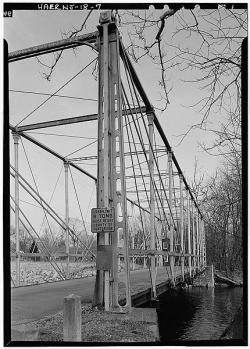
"Fink's truss design was one of a number of early patented solutions to [the problem of how] to carry a massive, moving weight (a train) over long spans (to avoid the expense of building piers and obstructing waterways) on easily erected bridges (often in rough terrain) with good long-term economy..."
- Kent Farnow Smith, "America's Oldest Functioning Iron-Truss Bridge," 1978
The widespread popularity in the 1850s and 1860s of the Fink through truss bridge, constructed from a design patented in 1854 by architect and civil engineer Albert Fink, represents a critical period in the evolution of civil engineering in America. With railroads expanding dramatically, a replacement for wooden bridges was needed that could be built quickly, cheaply, and with a reasonable assurance that it would survive for an extended length of time.
Fink's design combines elementary principles of bridge design with a practical application of available materials - cast and wrought iron - for the most efficient solution to building long-span bridges quickly and economically. By the mid-1870s, Fink's through truss bridges were eclipsed as bridge building grew more sophisticated, and steel emerged as a material better suited to bridge construction. The last of the Fink-designed bridges remaining in use was the 100-foot-long span at Hamden, New Jersey, which survived until 1978, when it was damaged in a vehicle collision. It has since been dismantled and stored for future restoration.


